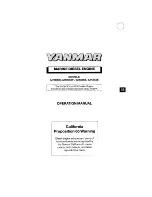
pressure loss of 0.25 MPa (2.5 bar). Consequently the discharge pressure of the circulating pumps may
rise to 1.05 MPa (10.5 bar), and the safety valve of the pump shall thus be adjusted e.g. to 1.2 MPa (12
bar).
•
A design pressure of not less than 1.2 MPa (12 bar) has to be selected.
•
The nearest pipe class to be selected is PN16.
•
Piping test pressure is normally 1.5 x the design pressure = 1.8 MPa (18 bar).
Example 2:
The pressure on the suction side of the cooling water pump is 0.1 MPa (1 bar). The delivery head of the
pump is 0.3 MPa (3 bar), leading to a discharge pressure of 0.4 MPa (4 bar). The highest point of the pump
curve (at or near zero flow) is 0.1 MPa (1 bar) higher than the nominal point, and consequently the discharge
pressure may rise to 0.5 MPa (5 bar) (with closed or throttled valves).
•
Consequently a design pressure of not less than 0.5 MPa (5 bar) shall be selected.
•
The nearest pipe class to be selected is PN6.
•
Piping test pressure is normally 1.5 x the design pressure = 0.75 MPa (7.5 bar).
Standard pressure classes are PN4, PN6, PN10, PN16, PN25, PN40, etc.
5.4
Pipe class
Classification societies categorize piping systems in different classes (DNV) or groups (ABS) depending on
pressure, temperature and media. The pipe class can determine:
•
Type of connections to be used
•
Heat treatment
•
Welding procedure
•
Test method
Systems with high design pressures and temperatures and hazardous media belong to class I (or group I),
others to II or III as applicable. Quality requirements are highest on class I.
Examples of classes of piping systems as per DNV rules are presented in the table below.
Gas piping is to be designed and manufactured and documented according to the rules of the relevant
classification society.
In the absence of specific rules or if less stringent than those of DNV the application of DNV rules is recom-
mended.
Relevant DNV rules:
•
Ship Rules Part 4 Chapter 6, Piping Systems
•
Ship Rules Part 5 Chapter 5, Liquefied Gas Carriers
•
Ship Rules Part 6 Chapter 13, Gas Fuelled Engine Installations
Table 5.2 Classes of piping systems as per DNV rules
Class III
Class II
Class I
Media
°C
MPa (bar)
°C
MPa (bar)
°C
MPa (bar)
and < 170
< 0.7 (7)
and < 300
< 1.6 (16)
or > 300
> 1.6 (16)
Steam
and < 60
< 0.7 (7)
and < 150
< 1.6 (16)
or > 150
> 1.6 (16)
Flammable fluid
-
-
-
-
All
All
Fuel gas
and < 200
< 1.6 (16)
and < 300
< 4 (40)
or > 300
> 4 (40)
Other media
5.5
Insulation
The following pipes shall be insulated:
•
All trace heated pipes
Product Guide Wärtsilä 34DF - 3/2012
31
Product Guide
5. Piping Design, Treatment and Installation
















































